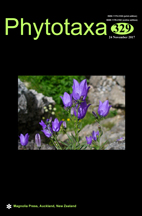Abstract
Paris Linnaeus (1753: 367) comprises 28 species of perennial herbs, mainly distributed in eastern Asia (Osaloo & Kawano 1999, Liang & Vitor 2000, Li et al. 2017, Ji et al. 2017, Wang et al. 2017). These species are also known as chong-lou in Chinese and are used as traditional medicines, the thick rhizome being used as analgesic, haemostatic, anticarcinogen, antineoplastic and anti-inflammatory (Wang et al. 2015, Li et al. 2015, 2017, Ji et al. 2017). This genus traditionally was placed in Liliaceae or Trilliaceae, which was divided into two genera based on floral merosity, namely Trilliun Linnaeus (1753: 340) and Paris (Li 1984; Zomlefer 1997; Li 1998). Paris was revised recently by molecular phylogenetic approaches and placed in Melanthiaceae (Ji et al. 2006, APG IV 2016, Kim et al. 2016).

